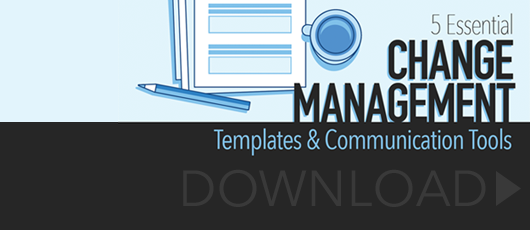3 Tips to Overcome Fear of Change in the Workplace
You’ve likely heard this saying many times before: “The only constant in life is change.” Yet if change is the one thing in life that’s inevitable, then why are we employees so horrible at dealing with it? One word: fear. Our fear of change in the workplace can inhibit our ability to embrace the new and better and focus our attention on something much more disengaging – the unknown.
Change within organizations often brings with it the unknown, and the unknown can cause people to go into panic mode. David Rock, author of the Handbook of Neuroleadership, explains that uncertainty registers as an error, gap, or tension in the brain: something that must be corrected before one can feel comfortable again. Not knowing what will happen next can be profoundly debilitating because it can overload cognitive resources, which can diminish memory, undermine performance, and disengage people from the present.
With that in mind, it’s essential that you make a conscious effort to overcome your fear of change in the workplace and remain engaged in the present. Keep reading for the three A’s on how to overcome your fear of change.
Acknowledge your comfort level with change.
We all cope with change differently, moving through it at varying speeds as we navigate our unique levels of uncertainty and ambiguity. For some employees, high uncertainty may be caused by a new manager, whereas other employees may only feel uncertain during full reorganizations of teams and reporting structures. One of best things you can do when dealing with fear of change in the workplace is acknowledging your own level of discomfort. How have you felt during prior changes? What were those changes? How long do you typically feel that way? Are you excited for changes or do you dread a potential new direction, role change, or expanded responsibility? Once you acknowledge your own level of comfort, you can recognize how you may impact others’ fear of change in the workplace and, more importantly, how to overcome your own fear of change.
Articulate the facts.
When an organization is evolving and confronting a change, water cooler discussions often become more frequent and less engaging. It’s easy during these times of uncertainty to latch onto details that provide you some level of comfort, even if it’s false certainty. We often imagine worst case scenarios just to provide what we think is clarity on a situation; however, it’s typically far from the reality. When trying to reduce the fear of change in the workplace, take time to articulate the facts. What did the organization communicate? Is there a timeline? What haven’t they communicated? What does the environment actually reflect? Have you been told how your role will change or if it will change? Can you discuss how you feel with your manager? Writing down the facts may help you distinguish fact from fiction and reduce the likelihood that you will fall victim to rumors. Focusing only on the facts is a big milestone on the path to overcoming your fear of change.
Activate on the change.
Instead of hiding from your fear of change in the workplace, overcome it by being open and flexible to taking on new challenges and tasks that align with the occurring changes. Maintain a high level of performance and engagement by actively participating and focusing your energy on developing new behaviors. Adopt an attitude of anticipation and excitement. Welcome change as an opportunity to involve yourself in new projects and teams. That way, you will more likely feel empowered and less fearful. Look for positivity in the path forward in order to develop new behaviors.
The next time you feel like your fear of change in the workplace is causing stress and disengagement, apply these three tips. For even more guidance on how to effectively communicating change to alleviate fear, check out the templates and communication tools below.






